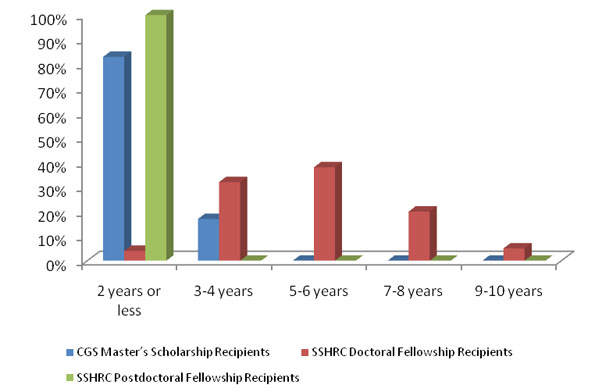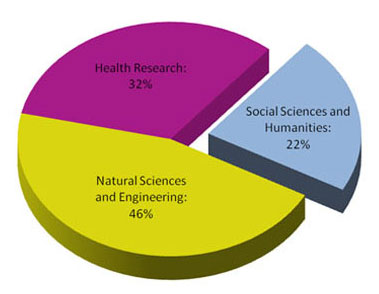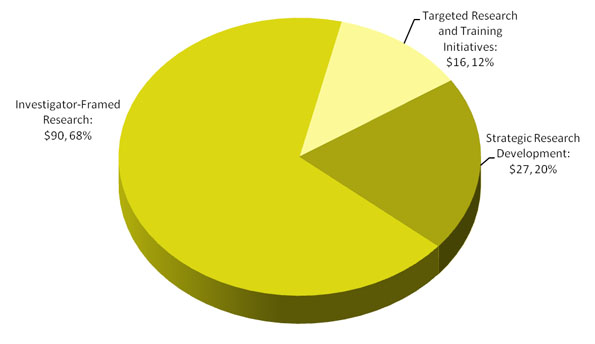ARCHIVED - Social Sciences and Humanities Research Council - Report
 This page has been archived.
This page has been archived.
Archived Content
Information identified as archived on the Web is for reference, research or recordkeeping purposes. It has not been altered or updated after the date of archiving. Web pages that are archived on the Web are not subject to the Government of Canada Web Standards. As per the Communications Policy of the Government of Canada, you can request alternate formats on the "Contact Us" page.
2010-11
Departmental Performance Report
Social Sciences and Humanities Research Council
The original version was signed by
The Honourable Christian Paradis
Minister of Industry and Minister of State (Agriculture)
Table of Contents
Section I: Organizational Overview
- Raison d’�tre
- Responsibilities
- Strategic Outcomes and Program Activity Architecture
- Organizational Priorities
- Risk Analysis
- Summary of Performance
- Expenditure Profile
- Estimates by Vote
Section II: Analyis of Program Activities by Strategic Outcome
- Strategic Outcome 1.0: People—A first-class research capacity in the social sciences and humanities
- Strategic Outcome 2.0: Research—New knowledge based on excellent research in the social sciences and humanities
- Strategic Outcome 3.0: Knowledge Mobilization—Facilitating the use of social sciences and humanities knowledge within and beyond academia
- Strategic Outcome 4.0: Institutional Environment—A strong Canadian science and research environment
Section III: Supplementary Information
Section VI: Other Items of Interest
Minister's Message

Last year, the Industry Portfolio played a key role in advancing the government’s agenda in Year 2 of Canada’s Economic Action Plan.
Specific stimulus measures taken by the Industry Portfolio under Canada’s Economic Action Plan were aimed at boosting economic development, supporting small and medium-sized enterprises, improving Canada’s research and development capacity and strengthening communities. The Portfolio’s stimulus measures targeted communities through the Marquee Tourism Events Program and the Broadband Canada: Connecting Rural Canadians program. Further investments in the Industrial Research Assistance Program, the Industrial Research and Development Internship Program, the Canada Graduate Scholarships Program and the Knowledge Infrastructure Program expanded Canada’s research and development capacity. Investing in the Canadian space industry maintained Canadian expertise and leadership in space robotics. Through these and other stimulus initiatives, we helped create jobs, build communities and nurture the roots of economic recovery.
In 2010–11, the Social Sciences and Humanities Research Council worked to develop Canadian research talent and promote research excellence and innovation in areas of vital importance to Canada’s economy. Through the Social Sciences and Humanities Research Council, Canadians invested $332 million in grants, fellowships and scholarships to help train the next generation of Canadian leaders and support the development of world-leading research in the social sciences and humanities. These grants also connect cutting-edge research to communities and businesses across the country, ensuring that all Canadians benefit from them.
Cultivating an environment for job creation, growth and competitiveness, both domestically and internationally, remains a priority for the Industry Portfolio. We will work to improve cost-effectiveness and efficiency and will contribute to the Government of Canada’s priority of balancing the budget and achieving real results for all Canadians.
It is my pleasure to present the Social Sciences and Humanities Research Council’s Departmental Performance Report for 2010–11.
Christian Paradis
Minister of Industry and Minister of State (Agriculture)
President's Message

Talent. Insight. Connection. These words capture how the social sciences and humanities focus on people in the past and present with a view toward creating a better future.
Talented leaders across society who understand the complexity, diversity and creativity of people, as individuals and as communities. Deep insights into human thought and behaviour as a foundation for informed thinking about critical social, cultural and economic issues. And strong connections linking academia, industry, government and communities in Canada and around the world in the development and use of social sciences and humanities research.
During 2010-11, the Social Sciences and Humanities Research Council (SSHRC) focused on the key priorities set out in Framing Our Direction by simplifying and consolidating our support for the best students, scholars and their research partners, and by enhancing our links to those who can put research knowledge to work across society.
The words, Talent, Insight and Connection, now define how SSHRC is supporting world-leading research and research training. Taken together, our new programs have begun deepening our knowledge and understanding of yesterday and today, with a view toward enhancing Canada and the world in the 21st century.
We also engaged with leaders and organizations across the public, private and not-for-profit sectors to promote the value of research in the social sciences and humanities, and to share the benefits of this work with them. Along the way, we contributed to many events such as the New Brunswick Innovation Forum, and the Canadian Science Policy Conference, as well as the annual Congress of the Humanities and Social Sciences. Throughout, we were met with keen interest and enthusiasm.
I am proud to present SSHRC’s Departmental Performance Report for the fiscal year 2010-11. The achievements outlined reflect the increasing interest in the social sciences and humanities, evidence of a growing awareness of how people—ideas and behaviour—are at the heart of successful innovation in the private, public and not-for-profit sectors. This awareness explains the increased currency of expressions like the customer-driven marketplace, user-engaged services, student-centered schools and citizen-engaged politics. People matter.
The new people-centered model of innovation calls upon all of us to rekindle the relationship between knowledge and society; to re-imagine and renew the historic covenant between campuses and the public; and to exploit all the ways of knowing about the past and present to tackle the world’s toughest challenges. Such innovation holds the promise of a productive and prosperous, resilient and safe, ethical and just society.
Chad Gaffield
President
Social Sciences and Humanities Research Council
Section I: Organizational Overview
Raison d’�tre
The Social Sciences and Humanities Research Council (SSHRC) funds research and research training that builds knowledge about people, past and present, with a view towards creating a better future. From questions of family and culture to concerns about jobs and employment, research about people—how we live, what we think and how we act—informs new knowledge and insights on the issues that matter most to Canadians.
SSHRC-funded research and research training play a unique role within Canada’s science, technology and innovation system, and are key to meeting Canada’s productivity agenda. Social sciences and humanities research fosters the development of the creative and analytical skills needed to respond to the complex emerging challenges of critical importance to Canadians. To this end, SSHRC’s strategic outcomes focus on people, research, knowledge mobilization and the institutional environment. These outcomes help further Canada’s advantages, as outlined in the federal science and technology (S&T) strategy, Mobilizing Science and Technology to Canada’s Advantage, as follows:
- people—creating a first-class research capacity in the social sciences and humanities to build a People Advantage;
- research excellence—creating new knowledge to heighten Canada’s Knowledge Advantage;
- knowledge mobilization—facilitating the use of research to contribute to Canada’s Entrepreneurial Advantage; and
- the institutional environment—providing Canada with a strong setting for science and research, and helping it achieve world-class excellence.
SSHRC actively contributes to the S&T strategy’s priority areas by supporting research and training related to a variety of key areas, including environmental science and technologies, finance and business, and new media and communications. The results of these and other investments are used by SSHRC-supported experts, in collaboration with key stakeholders from the private, public and not-for-profit sectors, to translate knowledge into new solutions and productive applications.
Through its ambitions of quality, connections and impact, as described in its strategic plan, Framing Our Direction 2010-12, SSHRC is continuing to build on its successes in supporting the federal S&T strategy. Moving forward, SSHRC will pursue these ambitions through three new umbrella programs—Talent, Insight and Connection—thereby creating a simpler structure for funding social sciences and humanities research excellence on issues of importance to Canadians.
Responsibilities
SSHRC is an agency that reports to Parliament through the minister of Industry. SSHRC was created through an act of Parliament in 1977 and mandated to:
- promote and assist research and scholarship in the social sciences and humanities; and
- advise the Minister in respect of such matters relating to such research as the Minister may refer to the Council for its consideration.
To fulfill its mandate, SSHRC offers programs that provide Canadian researchers and students with grants, scholarships and fellowships, respecting the terms of the federal Policy on Transfer Payments. SSHRC is also responsible for administering the following tri-agency programs, offered jointly with the Canadian Institutes of Health Research (CIHR) and the Natural Sciences and Engineering Research Council (NSERC):
- the Canada Research Chairs Program;
- the Canada Excellence Research Chairs Program; and
- the Indirect Costs Program.
In addition, SSHRC works with Industry Canada, as well as with CIHR and NSERC, to support Networks of Centres of Excellence initiatives. It also collaborates with CIHR and NSERC to deliver the Canada Graduate Scholarships, Vanier Canada Graduate Scholarships and Banting Postdoctoral Fellowships programs. SSHRC will continue to foster this collaboration for the benefit of all Canadians by building on the harmonization of tri-agency programs, practices and policies. In recent years, SSHRC, along with CIHR and NSERC, has also been working to increase connections across the three federal granting agencies through monthly meetings of the agencies’ presidents and senior executives.
SSHRC is governed by a 19-member council appointed by an order in council to reflect the perspectives of the academic, public and private sectors. SSHRC’s governing council promotes and assists research and scholarship in the social sciences and humanities. It meets regularly to set strategic policy and program priorities, allocate budgets, and advise the Minister of Industry and Parliament on research policy in these areas.
Strategic Outcomes and Program Activity Architecture

Priority Status Legend
Exceeded: More than 100 per cent of the expected level of performance (as evidenced by the indicator and target or planned activities and outputs) for the expected result or priority identified in the corresponding Report on Plans and Priorities (RPP) was achieved during the fiscal year.
Met all: 100 per cent of the expected level of performance (as evidenced by the indicator and target or planned activities and expected outputs) for the expected result or priority identified in the corresponding RPP was achieved during the fiscal year.
Mostly met: 80 to 99 per cent of the expected level of performance (as evidenced by the indicator and target or planned activities and expected outputs) for the expected result or priority identified in the corresponding RPP was achieved during the fiscal year.
Somewhat met: 60 to 79 per cent of the expected level of performance (as evidenced by the indicator and target or planned activities and outputs) for the expected result or priority identified in the corresponding RPP was achieved during the fiscal year.
Not met: Less than 60 per cent of the expected level of performance (as evidenced by the indicator and target or planned activities and outputs) for the expected result or priority identified in the corresponding RPP was achieved during the fiscal year.
Organizational Priorities
| Priority | Type | Strategic Outcomes |
|---|---|---|
| Strengthen the excellence of Canadian research and research training in the social sciences and humanities through improved research funding programs and processes | New | 1.0 People (Talent) 2.0 Research (Insight) |
| Status: Met all | ||
|
As part of a commitment to continuous improvement, in 2010-11 SSHRC continued its program architecture renewal (launched in 2009), reviewing its suite of funding programs, peer review processes and methods of program delivery, as well as revising its suite of funding opportunities. The outcomes sought included greater overall program coherence, with an improved and simplified interface for applicants and a greater emphasis on impacts and results achieved. Aspects of the new program architecture introduced in 2010-11 include the following:
|
||
| Priority | Type | Strategic Outcomes |
|---|---|---|
| Expand opportunities for collaborative knowledge-building on issues of importance to Canadians | New | 2.0 Research (Insight) |
| Status: Mostly met | ||
|
As was noted in the Science, Technology and Innovation Council’s State of the Nation 2008 report, there is growing evidence that the innovation system depends on linkages created between different researchers and research-performing institutions and sectors. These linkages intensify the research process and lead to better outcomes. To enhance its contribution to the innovation system and fulfill commitments stemming from the S&T strategy, SSHRC continued to align and harmonize its funding opportunities, procedures and policies with those of the other federal research granting agencies (CIHR and NSERC) and the Canada Foundation for Innovation.
|
||
| Priority | Type | Strategic Outcomes |
|---|---|---|
| Expand opportunities for collaborative knowledge-building on issues of importance to Canadians | New | 2.0 Research (Insight) |
| Status: Mostly met | ||
|
As was noted in the Science, Technology and Innovation Council’s State of the Nation 2008 report, there is growing evidence that the innovation system depends on linkages created between different researchers and research-performing institutions and sectors. These linkages intensify the research process and lead to better outcomes. To enhance its contribution to the innovation system and fulfill commitments stemming from the S&T strategy, SSHRC continued to align and harmonize its funding opportunities, procedures and policies with those of the other federal research granting agencies (CIHR and NSERC) and the Canada Foundation for Innovation.
|
||
| Priority | Type | Strategic Outcome |
|---|---|---|
| Facilitate the use of social sciences and humanities knowledge within and beyond academia | Ongoing | 3.0 Knowledge Mobilization (Connection) |
| Status: Met all | ||
|
SSHRC contributes to Canada’s Entrepreneurial Advantage by helping to make the knowledge resulting from funded research available to those who can benefit from it. By facilitating knowledge mobilization, SSHRC creates connections and intensifies the intellectual, social and economic impact of research and research training. SSHRC acted to ensure that results achieved by researchers, as well as the impacts of SSHRC investments, are documented and described in a way that is comprehensive, timely and fully informative. To those ends, SSHRC consolidated existing activities to facilitate, promote and report on results and impacts:
|
||
| Priority | Type | Strategic Outcome |
|---|---|---|
| Strengthen corporate management | Ongoing |
1.0 People (Talent) |
| Status: Met all | ||
|
Since 2006, SSHRC has been improving its corporate management, strengthening its governance structure, reconfiguring its council committees and aligning its internal governance with an integrated corporate management framework. These changes enable a more streamlined and rigorous approach to corporate planning, and enhance SSHRC’s effectiveness as an organization that serves the needs of Canadians. In 2010-11 SSHRC acted to ensure that its human resources and financial planning were integrated into the corporate management framework by:
|
||
Risk Analysis
SSHRC administers a significant budget, roughly $360 million for SSHRC programs and $330 million for the Indirect Costs Program. Despite this budget, the overall level of risk to the organization is low in terms of continuity of government operations, the maintenance of services to and protection of interests of the Canadian public, and the safety and security of the Canadian public.
A key challenge for the agency is ensuring the quality, credibility and viability of decision-making for the allocation of funding. Decisions about awards for most programs are based on recommendations from committees of experts and peers actively engaged in research of their own. This peer review process places emphasis on the quality of the proposed research and the track record of the researcher. Peer reviewers are not used for the Indirect Costs Program, which uses a formula to calculate the funding allocations for eligible institutions.
Like all organizations, SSHRC is exposed to a variety of risks that could have an impact on the achievement of its objectives and mandate. The ability to identify and respond to changing circumstances is critical to its success. To this end, SSHRC has adopted an integrated risk management framework, which takes a holistic and systematic approach to managing strategic, operational and project risks. The approach involves five basic steps: 1) identifying risk, 2) analyzing risk, 3) prioritizing risk, 4) resolving or mitigating risk, and 5) monitoring risk. In 2010-11, in alignment with Treasury Board guidelines, SSHRC developed its 2010-11 Corporate Risk Profile to formally identify and assess its corporate risks. The Corporate Risk Profile identifies four areas as high risk:
- Information Technology Innovation—ensuring the organization adequately leverages technology to support the needs of the organization, to promote efficiency or to innovate (e.g., services and processes);
- Project Management Capability—ensuring the organization has the required capabilities, tools and dedicated expertise to effectively manage key projects;
- Sufficiency of Operating Budget—ensuring that allocated operating funding is sufficient to support program/project delivery requirements; and
- Decision-Making Authority/Accountability—ensuring the organization is effectively establishing authority/accountability to allow for effective and timely decision-making.
Subsequent to the Corporate Risk Profile, SSHRC developed a corporate risk management framework to ensure that each risk would be systematically monitored by senior management. The framework integrates the results of the Corporate Risk Profile, while identifying triggers, controls and mitigation strategies for each risk. The framework also outlines processes and expectations for the ongoing monitoring and reporting of risks throughout SSHRC’s integrated planning cycle.
To ensure that its credibility and decision-making processes continue to be transparent and rigorous, SSHRC is committed to continuously improving its risk management processes and practices.
Summary of Performance
A large portion of SSHRC grants and awards expenditures funded the strategic outcomes People (26 per cent) and Research (20 per cent), and five per cent supported Knowledge Mobilization. SSHRC’s largest single expense (49 per cent) is funding indirect costs of research on behalf of the three federal research granting agencies.
SSHRC's Actual Spending by Strategic Outcome, 2010-11 ($ millions)

Research areas that fall under S&T priorities make up 26 per cent of SSHRC grants and awards investments. SSHRC’s investment in S&T research areas has decreased slightly, from 29 per cent, or by $9 million, since 2009-10. Social development research comprises the second-largest research area (18 per cent). Of this decline, $6 million is attributable to reduced support for health and related life sciences research, part of the continued implementation of the 2008 strategic review.
Allocation of SSHRC Grants and Scholarships Expenditures by Research Area, 2010-11 ($ millions and %)

2010-11 Financial Resources ($ millions)
| Planned Spending | Total Authorities | Actual Spending |
|---|---|---|
| 678.5 | 692.0 | 689.1 |
2010-11 Human Resources (full-time equivalents)
| Planned | Actual | Difference |
|---|---|---|
| 227 | 213 | -14 |
| Strategic Outcome 1.0: People—A first-class research capacity in the social sciences and humanities | ||
|---|---|---|
| Performance Indicators | Targets | 2010-11 Performance |
| Degree completion—Canadian graduate students vs. other Organisation for Economic Co-operation and Development (OECD) nations | Top 10 international ranking | 13th of 31 OECD nations |
| Proportion of Chairs awarded to Canadians, returning expatriates and foreigners | 75 per cent recruited from within Canada, 25 per cent recruited from abroad (12.5 per cent expatriate Canadians,12.5 per cent foreigners) | 70 per cent recruited from within Canada, 30 per cent recruited from abroad (14 per cent expatriate Canadians, 16 per cent foreigners) |
| 2010-11 Performance | ||
|
Two-thirds of Canada’s postsecondary student population (including 64,740 full-time graduate students) study in the humanities and social sciences. The provision of scholarships and fellowships to graduate-level students is a direct way to support the development of the best and brightest research talent. People with graduate degrees in the social sciences and humanities have research skills that provide Canada with a highly qualified workforce in academia and in the knowledge and service sectors that is fundamental to success in the 21st century. In 2010-11, SSHRC awarded scholarships and fellowships to 1,500 full-time master’s students and 930 doctoral candidates, enabling them to receive research training in a variety of fields, and gain skills and experience that will help them build successful careers in all sectors of society. SSHRC also administered the Canada Research Chairs Program on behalf of SSHRC, CIHR and NSERC. Through salary and research funding for university research professorships, the program attracted and retained the best and most productive researchers within Canadian postsecondary institutions. These researchers, in turn, attracted and supported the best and most promising new scholars and graduate students. By cultivating research excellence in Canadian universities and colleges, the program has branded Canada as a top destination for research. Following on Budget 2008, SSHRC initiated planning and implementation of the Canada Excellence Research Chairs Program. Together with CIHR and NSERC, SSHRC implemented the federal government’s flagship Vanier Canada Graduate Scholarships program. Notable successes in 2010-11 included the following:
|
||
| Strategic Outcome 2.0: Research—New knowledge based on excellent research in the social sciences and humanities | ||
|---|---|---|
| Performance Indicators | Targets | 2010-11 Performance |
| Applications in designated funding opportunities identify priority areas | 70 per cent | 75 per cent |
| Average research contributions per grant | 14 | 16 |
| 2010-11 Performance | ||
|
SSHRC’s investments in research result in the creation of new knowledge. As Canada increasingly recognizes the importance of knowledge as a commodity, and as world economies become increasingly knowledge-based, SSHRC’s support of research achievements reflects the commitments in the federal government’s science, technology and innovation agenda. SSHRC’s program activities support and advance postsecondary institution-based research. Grants awarded to top researchers build a store of knowledge that allows Canada to respond to the forces of change—social, political, cultural and economic. In 2010-11:
|
||
| Strategic Outcome 3.0: Knowledge Mobilization—Facilitating the use of social sciences and humanities knowledge within and beyond academia | ||
|---|---|---|
| Performance Indicator | Target | 2010-11 Performance |
| Ratio of actual financial contributions leveraged via Connection grants compared to SSHRC funding | 0.35:1 | 0.39:1 |
| 2010-11 Performance | ||
|
A knowledge-based society requires effective and productive interaction and collaboration between those who perform research and those who use it (i.e., knowledge mobilization). SSHRC’s support of knowledge exchange, dissemination, translation and outreach created connections between the research community and the larger community. Grants enable the exchange of ideas and foster an entrepreneurial attitude towards research results, thereby supporting Canada’s transition to a knowledge-based society. SSHRC awarded 270 grants, totalling slightly more than $8.5 million, to researchers and institutions to carry out activities supporting direct and effective implementation of research and research results, including:
|
||
| Strategic Outcome 4.0: Institutional Environment—A strong Canadian science and research environment | ||
|---|---|---|
| Performance Indicator | Target | 2010-11 Performance |
| Number of Canadian universities appearing in Top 300 QS World University Rankings | 16 | 16 |
| 2010-11 Performance | ||
|
Institutions funded by the Indirect Costs Program used their grants largely for management and administration, and for research facilities. Combined, these two categories have accounted for two-thirds of total spending since the program’s inception. The distribution of funds among the five expenditure areas has remained fairly stable since the program’s inception, with a gradual increase in the proportion of funds allotted to regulatory requirements and accreditation, as well as to management and administration, offset by a similar decline in the proportion spent on resources and facilities. In 2010-11, SSHRC, on behalf of the three federal research funding agencies, allocated $329.4 million in Indirect Costs grants to more than 140 eligible Canadian postsecondary institutions. |
||
| Program Activity 5.1: Internal Services |
|---|
| 2010-11 Performance |
|
SSHRC is small in terms of the number of employees and its salary and non-salary budget. Over the past 15 years, there has been a conscious effort to keep operating envelopes lean. This, in turn, has maximized the value and impact of the grants and scholarships programs for the social sciences and humanities community. Operating expenditures were also greatly assisted by the involvement of external experts who voluntarily contributed their time in 2010-11 to the peer review process of grant and scholarship applications. These services alone were valued at approximately $5 million annually. SSHRC’s lean operating budget has been assisted by the shared management services arrangement between NSERC and SSHRC. This year, SSHRC spent four per cent of its overall budget on operating costs, making 96 per cent of its budget available directly to researchers and institutions across Canada to support university- and college-based research and training in the humanities and social sciences. Taken together, the focus remains on continuous improvement and finding further efficiencies and savings, where possible, through streamlining, standardizing and automating systems and processes, as well as managing within government-wide budget constraint measures. |
($ millions)
| Program Activity | 2009-10 Actual Spending | 2010-11 | Alignment to Government of Canada Outcome | |||
|---|---|---|---|---|---|---|
| Main Estimates | Planned Spending | Total Authorities | Actual Spending | |||
| Strategic Outcome 1.0: People—A first-class research capacity in the social sciences and humanities | ||||||
| 1.1 Fellowships, Scholarships and Prizes | 117.4 | 118.3 | 118.3 | 120.1 | 119.3 | An innovative and knowledge -based economy |
| 1.2 Research Chairs | 55.7 | 61.0 | 61.0 | 61.1 | 55.0 | |
| Total | 173.1 | 179.3 | 179.3 | 181.2 | 174.3 | |
($ millions)
| Program Activity | 2009-10 Actual Spending | 2010-11 | Alignment to Government of Canada Outcome | |||
|---|---|---|---|---|---|---|
| Main Estimates | Planned Spending | Total Authorities | Actual Spending | |||
| Strategic Outcome 2.0: Research—New knowledge based on excellent research in the social sciences and humanities | ||||||
| 2.1 Investigator-Framed Research | 85.7 | 82.0 | 82.0 | 82.2 | 89.8 | An innovative and knowledge -based economy |
| 2.2 Targeted Research and Training Initiatives | 23.8 | 19.8 | 19.8 | 20.4 | 16.0 | |
| 2.3 Strategic Research Development | 25.6 | 26.3 | 26.3 | 29.3 | 27.0 | |
| Total | 135.1 | 128.1 | 128.1 | 131.9 | 132.8 | |
($ millions)
| Program Activity | 2009-10 Actual Spending | 2010-11 | Alignment to Government of Canada Outcome | |||
|---|---|---|---|---|---|---|
| Main Estimates | Planned Spending | Total Authorities | Actual Spending | |||
| Strategic Outcome 3.0: Knowledge Mobilization—Facilitating the use of social sciences and humanities knowledge within and beyond academia | ||||||
| 3.1 Research Dissemination and Knowledge Translation | 9.9 | 7.2 | 7.2 | 7.2 | 8.9 | An innovative and knowledge- based economy |
| 3.2 Research Networking | 26.0 | 21.3 | 24.9 | 24.0 | 26.1 | |
| Total | 35.9 | 28.5 | 32.1 | 31.2 | 35.0 | |
($ millions)
| Program Activity | 2009-10 Actual Spending | 2010-11 | Alignment to Government of Canada Outcome | |||
|---|---|---|---|---|---|---|
| Main Estimates | Planned Spending | Total Authorities | Actual Spending | |||
| Strategic Outcome 4.0: Institutional Environment—A strong Canadian science and research environment | ||||||
| 4.1 Indirect Costs of Research | 324.9 | 322.4 | 322.4 | 329.7 | 329.7 | An innovative and knowledge- based economy |
| Total | 324.9 | 322.4 | 322.4 | 329.7 | 329.7 | |
($ millions)
| Program Activity | 2009-10 Actual Spending | 2010-11 | |||
|---|---|---|---|---|---|
| Main Estimates | Planned Spending | Total Authorities | Actual Spending | ||
| 5.1 Internal Services | 17.4 | 674.9 | 16.6 | 18 | 17.3 |
Expenditure Profile
During the 2010-11 fiscal year, SSHRC spent $689.1 million (including Indirect Costs Program expenditures) to meet the expected results of its program activities and to contribute to its strategic outcomes. SSHRC’s total actual spending for 2010-11 was $359 million for core programs and $330 million for the Indirect Costs Program (excluding operating expenditures). The figure below illustrates SSHRC’s spending trend since 2006-07.
Canada’s Economic Action Plan
Budget 2009 provided a temporary increase of $17.5 million for SSHRC to fund 500 additional doctoral and master’s scholarships over three years beginning in 2009-10. These scholarships are targeted to high-performing graduate students undertaking research training in business-related areas. In 2010-11, SSHRC delivered on its commitment to Canada’s Economic Action Plan by awarding 200 Joseph-Armand Bombardier Canada Graduate Scholarships Master’s Scholarships, totalling $3.5 million.
Departmental Spending Trend ($ millions)

Estimates by Vote
For information on SSHRC’s organizational votes and/or statutory expenditures, please see the 2010-11 Public Accounts of Canada (Volume II) publication. An electronic version of the Public Accounts is available at www.tpsgc-pwgsc.gc.ca/recgen/txt/72-eng.html.
Section II: Analysis of Program Activities by Strategic Outcome
Strategic Outcome 1.0: People—A first-class research capacity in the social sciences and humanities
It is widely recognized that for Canada to gain economic advantage and become a truly innovative nation, we need skilled people who can succeed in a knowledge-based global society. SSHRC’s first strategic outcome focuses squarely on ensuring that Canada is able to develop the research capacity our country needs to succeed in the 21st century. SSHRC awards fellowships and scholarships to promising students at the master’s, doctoral and postdoctoral levels to train the knowledge-workers of tomorrow. It bestows prestigious research chairs in the social sciences and humanities to attract and retain top researchers. It also offers prizes to recognize and inspire the highest standards of scholarship.
Distribution of Spending in the Area of People, 2010-11 ($ millions and %)

A major report released in 2011 by Canada’s Science, Technology and Innovation Council stated that harnessing an excellent talent pool is the key to lifting Canada into the top tier of innovation leaders. In 2010-11, the Social Sciences and Humanities Research Council (SSHRC) awarded fellowships and scholarships to 1,500 full-time master’s students and 930 doctoral candidates, to receive research training in a variety of social sciences and humanities disciplines, and to gain skills and experience that will help them build successful careers in all sectors of society. Further, 123 of these graduate students also received Canada Graduate Scholarships—Michael Smith Foreign Study Supplements to pursue research study opportunities outside Canada, thereby gaining valuable international experience and strengthening collaboration between Canadian and foreign universities. To assist new scholars in establishing a research base at a critical early point in their careers SSHRC also awarded 211 SSHRC Postdoctoral Fellowships to the most promising new researchers in the social sciences and humanities.
SSHRC also administers the Canada Research Chairs Program on behalf of SSHRC, the Canadian Institutes of Health Research (CIHR) and the Natural Sciences and Engineering Research Council NSERC). The program was designed to create 2,000 high-profile research professorships for established and up-and-coming researchers at Canadian universities. Attracting internationally renowned scholars, the program helps keep research jobs and expertise in Canada, and increases national research capacity in social sciences, humanities, engineering, health sciences, and natural sciences. SSHRC’s president serves as chair of the program’s steering committee.
Following on Budget 2008, SSHRC initiated planning and implementation of the Canada Excellence Research Chairs Program.
The Research Chairs program activity invested $55 million in more than 400 chairs to attract and retain some of the world’s most accomplished and promising minds in the social sciences and humanities.
Program Activity 1.1: Fellowships, Scholarships and Prizes
SSHRC offers several award programs for advanced study and research in the social sciences and humanities at the master’s, doctoral and postdoctoral levels. These programs help train Canada’s researchers and the leaders of tomorrow. In addition, SSHRC offers special fellowships to experienced researchers, and supplementary awards to outstanding doctoral and postdoctoral fellowship recipients. Finally, two commemorative prizes recognize the extraordinary dedication and creativity of Canada’s best researchers.
2010-11 Financial Resources ($ millions)
| Planned Spending | Total Authorities | Actual Spending |
|---|---|---|
| 118.3 | 120.1 | 119.3 |
2010-11 Human Resources (full-time equivalents [FTEs])
| Planned | Actual | Difference |
|---|---|---|
| 19 | 24 | +5 |
| Expected Results | Performance Status |
|---|---|
| Highly qualified personnel, expert in research, are available to pursue knowledge-intensive careers within universities, industry, government and other sectors. | Mostly met |
Performance summary and analysis of program activity
In 2010-11, SSHRC awarded 2,835 master’s, doctoral and postdoctoral fellowships, scholarships and special prizes to some of the best and brightest students and researchers in the social sciences and humanities. The following table details the results of the highly competitive fellowships and scholarships competitions held in 2010-11, which awarded 2,819 fellowships and scholarships totalling nearly $120 million.
| Program | Description | Targets 2010-11 | Results 2010-11 | Expenditures 2010-11 ($ millions) |
|---|---|---|---|---|
| Joseph-Armand Bombardier Canada Graduate Scholarships (CGS) Master’s Scholarships | The Joseph-Armand Bombardier CGS Master’s Scholarships funding opportunity seeks to develop research skills and assist in the training of highly qualified personnel by supporting students in the social sciences and humanities who demonstrate a high standard of achievement in undergraduate and early graduate studies. |
1,300 open awards 200 business-related awards |
1,300 open awards 200 business-related awards |
28.2
|
|
Joseph-Armand Bombardier Canada Graduate Scholarships (CGS) Doctoral Scholarships |
The Joseph-Armand Bombardier CGS Doctoral Scholarships aim to develop research skills and assist in the training of highly qualified personnel by supporting students who demonstrate a high standard of scholarly achievement in undergraduate and graduate studies in the social sciences and humanities. | 430 awards | 430 awards | 46.0 |
| Georges Phileas Vanier Canada Graduate Scholarships(Vanier CGS) | The Vanier CGS was created to attract and retain world-class doctoral students and to brand Canada as a global centre of excellence in research and higher learning. It is worth $50,000 per year for three years, and is available to both Canadian and international PhD students studying at Canadian universities. | 55 awards | 55 awards | 5.5 |
| Canada Graduate Scholarships—Michael Smith Foreign Study Supplements (CGS-MSFSS) |
The CGS-MSFSS supports high-calibre Canadian graduate students in building global linkages and international networks through the pursuit of exceptional research experience abroad. By accessing international scientific research and training, CGS-MSFSS recipients contribute to strengthening the potential for collaboration between Canadian universities and affiliated research institutions and universities, or other research institutions outside of Canada. Supplements of up to $6,000 are available to active CGS master’s, CGS doctoral or eligible Vanier CGS holders, to help offset the costs of undertaking research studies outside Canada for a defined period. |
125 awards | 123 awards* | 0.7 |
| SSHRC Doctoral Fellowships | The SSHRC Doctoral Fellowships funding opportunity aims to develop research skills and assist in the training of highly qualified personnel by supporting students who demonstrate a high standard of scholarly achievement in undergraduate and graduate studies in the social sciences and humanities. | N/A | 500 awards | 26.1 |
| SSHRC Postdoctoral Fellowships | The SSHRC Postdoctoral Fellowships program supports the most promising Canadian new scholars in the social sciences and humanities and assists them in establishing a research base at an important time in their research careers. | N/A | 211 awards | 10.3 |
*The discrepancy between targeted and actual CGS-MSFSS awards arose because not all those eligible: a) apply for the supplement, or b) are able to meet the conditions of using the supplement during the tenure of their CGS award.
Distribution of Grants and Scholarships Spending in the Area of Fellowships, Scholarships and Prizes, 2010-11 ($ millions and %)


In consultation with the other federal research granting agencies, full harmonization of the Canada Graduate Scholarships (CGS) tri-agency program, including the Joseph-Armand Bombardier CGS Program Doctoral Scholarships, was postponed to next fiscal year and will be carried out as part of SSHRC’s review and renewal of the suite of Talent programs.
Together with CIHR and NSERC, SSHRC implemented the federal government’s flagship Georges Phileas Vanier Canada Graduate Scholarships (Vanier CGS) program. In 2010-11, the second year of the program, the three granting agencies finished integrating the resources and mechanisms for delivery of the program, and achieved the full uptake of 500 awards. They also developed a performance measurement strategy to monitor the performance of the Vanier CGS program.
The Value of Vanier Around the World
“Personally and practically, the Vanier scholarship makes my field trips more flexible . . . I applied for the visiting researcher position at Sophia University [Tokyo, Japan]. It was approved very quickly. It turned out that the Vanier scholarship was one of the most important elements in the evaluation process.”
Xin Chen, Vanier CGS recipient
SSHRC awarded 58 CGS master’s scholarships to applicants undertaking business-related research, bringing to 200 the total number of awards in two competitions. This element of Canada’s Economic Action Plan has now been fully implemented.
Following a recommendation of the 2010 SSHRC Doctoral Fellowship Review, a logic model of the program and a comprehensive performance measurement strategy were developed to ensure that performance information is systematically monitored and collected.
A second round of the SSHRC Scholarships and Fellowships Survey was launched in March 2011, with the final report expected by September 2011 (the final report of the first round of the survey can be viewed here). The survey will assess the career progression of a new cohort of SSHRC CGS master’s scholars and doctoral and postdoctoral fellows, to compare trends in employment. The survey of SSHRC scholarship and fellowship award holders will be conducted on a regular two-year basis.
The 2010 survey results regarding time to completion for SSHRC scholarship and fellowship award holders appear in the following box.
Time to Completion for SSHRC Scholarship and Fellowship Recipients
SSHRC scholarships and fellowships time to completion
- On average, more than 90 per cent of the SSHRC respondents completed their graduate degree or research program, with the highest percentage of completion attained among CGS master’s scholarship recipients (97 per cent) and the lowest among postdoctoral researchers (81 per cent).
- The median time to completion was just under two years for SSHRC CGS master’s scholarship recipients, five years and eight months for doctoral fellowship award holders, and one year and eight months for postdoctoral researchers.
- The time to completion for SSHRC master’s and doctoral recipients is shorter than the Canadian median.
Canada’s Economic Action Plan
Budget 2009 provided $17.5 million over three years to the CGS program for SSHRC to fund 500 additional doctoral and master’s scholarships beginning in 2009-10. In 2010-11, these funds provided an additional 200 master’s scholarships, valued at $17,500 each for one year.
Additional Business-Related Canada Graduate Scholarships Awarded in 2010-11
| CGS Master’s Scholarships | ||
|---|---|---|
| Increased Number of Scholarships | Value of Each Award (per year) | Actual Spending |
| 200 | $17,500 | $3.5 million |
This initiative is helping to train highly skilled graduate students on issues related to business. These individuals will go on to work in all sectors of the economy, bringing with them new knowledge and understanding of business issues.
Lessons learned
The SSHRC Postdoctoral Fellowships funding opportunity data show that, overall, there is a consistent number of successful applicants per year who decline the grant (between 1993 and 2010, an average of 20 successful applicants per year declined the grant). To investigate the factors behind these refusals, SSHRC launched a survey of SSHRC postdoctoral fellows who did not accept the award. The results of the exit survey were as follows:
SSHRC Postdoctoral Fellowships—Exit Survey Results
- Ninety-two per cent of the respondents stated that the main reason for declining the SSHRC Postdoctoral Fellowship was that they found employment.
- Ninety-two per cent of those who had found employment were employed in the university sector.
- Eighty-five per cent were employed in a full-time position.
- Sixty-two per cent are currently employed in Canada, while 23 per cent are employed in the United States.
- The majorityn (54 per cent) of the respondents who are currently employed declared a total annual income between $65,000 to $74,999.
- Preliminary findings from the SSHRC Postdoctoral Fellowships evaluation indicate that the program is successful in selecting the best among promising researchers.
Following this experience, SSHRC will continue the survey, and extend it to recipients of other SSHRC master’s scholarship and doctoral scholarship and fellowship funding opportunities who declined their awards. This survey, along with the biannual SSHRC Scholarships and Fellowships Survey and improved reporting on results, will enable SSHRC to better monitor and report on the results of its scholarships and fellowships programs.
Program Activity 1.2: Research Chairs
Chairs programs support faculty positions within postsecondary and research institutions by providing funding for salaries and research activities. Chairs programs serve to attract the best and most productive researchers to Canada, and to retain those already here. In turn, these top researchers attract and support the best and most promising new scholars and graduate students. Ultimately, this helps to cultivate centres of world-class research excellence at Canadian universities, and to brand Canada as a top destination for research.
2010-11 Financial Resources ($ millions)
| Planned Spending | Total Authorities | Actual Spending |
|---|---|---|
| 61.0 | 61.1 | 55.0* |
2010-11 Human Resources (FTEs)
| Planned | Actual | Difference |
|---|---|---|
| 15 | 10 | -5 |
| Expected Results | Performance Status |
|---|---|
| World-class researchers are attracted to enhance research capacity in Canadian universities and research institutes, and to build critical mass of expertise in priority S&T areas. | Mostly met |
Performance summary and analysis of program activity
| Program | Description | Targets 2010-11 | Results 2010-11 | Expenditures 2010-11 ($ millions) |
|---|---|---|---|---|
| Canada Research Chairs | The Canada Research Chairs Program aims to invest $300 million per year to attract and retain some of the world’s most accomplished and promising minds. Chairholders aim to achieve research excellence in engineering and the natural sciences, health sciences, humanities, and social sciences. They improve our depth of knowledge and quality of life, strengthen Canada’s international competitiveness, and help train the next generation of highly skilled people through student supervision, teaching and the co-ordination of other researchers’ work. | 2,000 chairs; 400 within SSHRC’s mandate area | 1,845 chairs;* 400 within SSHRC’s mandate area | 53.7 (for Chairs within SSHRC’s mandate area) |
| Canada Excellence Research Chairs | The ability to attract the highest calibre of researchers and scholars is a critical factor for Canada’s future prosperity. As a result, the Government of Canada designed the Canada Excellence Research Chairs Program to attract Canadian and international leading scientists and scholars who can contribute positively to Canada’s global competitiveness and well-being, and to help Canadian universities compete in the global market for research talent. Chairholders’ work will spark the creation of new services and policies that support Canada’s economic competitiveness, help sustain the environment, and improve quality of life. | Up to 20 chairs | 19 chairs | 0 (all Chairs were within CIHR and NSERC’s mandate areas) |
Canada Research Chairs
At the end of November 2010, there were 1,845 active Canada Research Chairs at 72 universities across Canada, in all discipline areas. Of these positions, 30 per cent were filled by researchers recruited from abroad, including 256 Canadian expatriates. At that time, 400 (22 per cent) of active Canada Research Chairs were in
the social sciences and humanities, and therefore funded by SSHRC. A total of 310 new or renewed Chairs in all discipline areas were announced in 2010-11.
Percentage of Active Chairs by Main Discipline, 2010-2011
Preventing Medication Errors Through Quality Management
At St. Francis Xavier University, Canada Research Chair Todd Boyle used a SSHRC grant to develop SafetyNET-Rx. This integrated reporting tool allows pharmacies to systematically assess and validate quality management practices and, ultimately, prevent medication errors that can endanger the lives of Canadians. The provincial regulatory board for pharmacies now requires community pharmacies to either adopt SafetyNET-Rx or show that their current continuous quality improvement process includes the tool’s core components.
The 10th-year evaluation of the Canada Research Chairs Program was formally accepted by the Steering Committee in January 2011. The evaluation findings and recommendations informed the renewal of the program’s terms and conditions in March 2011. Evidence from the evaluation suggests that the program was associated with the following outcomes:
Canada Research Chairs Program 10th-Year Evaluation—Key Findings
- Sixty-eight per cent of Canada Research Chair holders originated from within Canada, and 32 per cent came—or returned—to Canada from international institutions. About half of the Chairs were used for retention by institutions.
- The Canada Research Chairs Program has helped alleviate barriers to attraction and retention, especially by allowing universities to offer more appealing packages to researchers, notably through the Canada Foundation for Innovation component, which provides funding for infrastructure.
- Canada Research Chair holders produce a greater number of peer reviewed papers, are cited more frequently, and are more often published in high-impact journals than comparable groups of leading researchers.
- The knowledge generated by Canada Research Chair holders was more frequently reported to have been used (e.g., taken up or applied, including by external organizations) and/or to have generated impacts than that generated by comparable groups.
- The program increased universities’ research capacity in the designated strategic areas of research through the creation and enhancement of research centres and clusters around chairholders, the development of collaborative practices and opportunities, and the bolstering of Canada’s international research reputation.
- The program helped to strengthen the training of highly qualified personnel.
Canada Excellence Research Chairs
The first recipients of Canada Excellence Research Chairs were announced in May 2010. Nineteen chairs at 13 Canadian universities were awarded to world-class researchers from abroad to establish research teams, with a total amount up to $190 million over seven years. The chairs were awarded in the four priority areas outlined in the Government of Canada S&T
strategy as follows:
- four chairs focused on information and communications technologies;
- six on health and related life sciences and technologies;
- four on natural resources and energy; and
- five on environmental sciences and technologies, including one pertinent to the automotive industry.
As all chairs awarded fell within CIHR and NSERC’s mandate areas, grants funding for these chairs will flow through these agencies.
A performance measurement strategy, including a risk-assessment strategy, was developed for the program and is being implemented by the Chairs Secretariat.
Lessons learned
The 10th-year evaluation of the Canada Research Chairs Program indicated that the program was well managed and efficient, with some effective improvements made during its life cycle. The evaluation’s recommendations to ensure the long-term success of the program included:
- revising the chair award amounts to ensure that the program can continue to effectively meet its objectives;
- managing the transition and retention of Tier 2 chairholders after the end of their second terms; and
- providing advice and guidance to universities on best practices for managing their Chair awards.
In response to these recommendations, the Steering Committee committed to working with universities to improve the program, for example, by:
- assessing the impact of the value of the award on the success of the program;
- monitoring the career path of Tier 2 Chairs after their second term;
- exploring additional mechanisms for minimizing the disruption caused by the loss of Chairs at an institution; and
- exploring mechanisms to increase monitoring of chairholders’ progress in order to quickly resolve any issues and ensure that the Chairs program is achieving its objectives.
Creating Opportunities
"The Canada Research Chair has been a most rewarding experience not just for me, but also for my colleagues at the University of Regina. The funds have provided opportunities that are not normally available to scholars working in the humanities."
Shadia Drury—Canada Research Chair in Social Justice, University of Regina
Strategic Outcome 2.0: Research—New knowledge based on excellent research in the social sciences and humanities
SSHRC’s investments in research result in the creation of new knowledge. As Canada increasingly recognizes the importance of knowledge as a commodity, and as world economies become increasingly knowledge-based, SSHRC’s research achievements are particularly significant.
Just as the S&T strategy reflects the federal government’s commitment to supporting “basic research across a broad spectrum of science,” as well as “applied research in areas of strength and opportunity,” SSHRC’s program activities in support of investigator-framed research and targeted and strategic research advance both elements of the science, technology and innovation agenda. Grants awarded to top researchers build a store of knowledge that will allow Canada to respond to the forces of change, be they social, economic or political. Specific investments, such as those addressing Canada’s Northern Strategy or aiming to improve business practices in Canada, illustrate SSHRC’s commitment to advancing the government’s vision and change agenda to benefit Canadians. Looking forward, SSHRC is enhancing its ability to support science and innovation through programming offered in partnership with the private, public and not-for-profit sectors.
Distribution of Spending in the Area of Research, 2010-11 ($ millions and %)
In 2010-11, SSHRC awarded 1,276 new grants to researchers to carry out world-class research at postsecondary institutions across Canada. Grants were awarded to enhance knowledge and understanding of the past and present, and to inform thinking about critical social, cultural, economic, technological and environmental issues, both within the research community and across the public, not-for-profit and private sectors.
SSHRC awards grants based on independent adjudication of research proposals. Expert selection committees evaluate, rank and recommend which proposals to fund, based on criteria such as the originality and significance of the research, the quality of training offered to students, and the potential impacts of the research within and outside the academic world. More than 300 committee members participated in SSHRC research application adjudication in 2010-11. A further 5,800 written assessments of proposals supported the work of the expert selection committees.
Demand for Social Sciences and Humanities Research
Findings from recent SSHRC studies have indicated that there is significant demand in the public and private sectors for social sciences and humanities research. According to a 2010-11 study by the Impact Group, traditional grant-funded research is critical for establishing the foundation of knowledge that external customers and clients draw on, generating positive impacts on government, not-for-profit organizations and the private sector, creating real value in terms of additional learning opportunities for researchers, students, institutions, and communities. It was estimated that third-party contracting in the social sciences and humanities at postsecondary institutions could represent as much as $100 million of activities per year. Over 50 per cent of this contracting was commissioned by the public sector on such issues as law reform, demographic change, macro- and micro-economic analysis, security, and telecommunications policy. Through such contracts, SSHRC funding is leveraged and dispersed throughout the economy via knowledge creation, wages and stipends, purchase of goods and services, etc. Such impacts contribute significantly to the economies of smaller centres and areas that rely heavily on the economic activity generated by institutions.
Program Activity 2.1: Investigator-Framed Research
SSHRC research grants support individual and team projects and programs of research for which the applicant(s) proposes/propose the research topic and methodology. These range from individuals or small groups working in libraries and archives to large, multidisciplinary, collaborative projects with researchers, partners and assistants conducting fieldwork across the country.
Distribution of Grants and Scholarships Spending in the Area of Investigator-Framed Research, 2010-11 ($ millions and %)
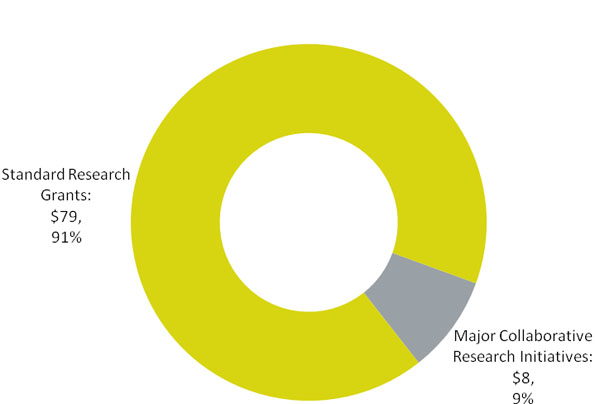
2010-11 Financial Resources ($ millions)
| Planned Spending | Total Authorities | Actual Spending |
|---|---|---|
| 82.0 | 82.2 | 89.8* |
2010-11 Human Resources (FTEs)
| Planned | Actual | Difference |
|---|---|---|
| 34 | 35 | +1 |
| Expected Results | Performance Status |
|---|---|
| Investigator-framed research creates a synergy contributing to observable knowledge advancement and dissemination of research results throughout the academic community and beyond. | Met all |
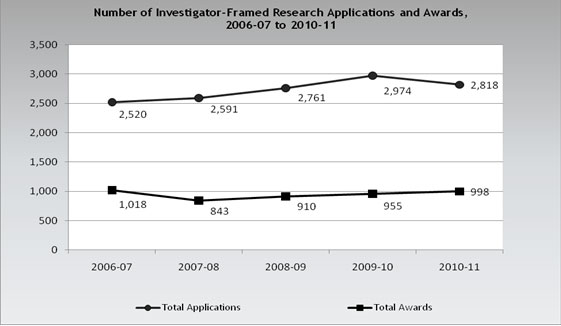
A number of SSHRC programs marked their final competitions in 2010-11, as the organization transitioned to a new program architecture. In fall 2010, SSHRC launched its Insight Development Grants funding opportunity supporting research in its early stages, carried out by individuals or teams. These grants, valued at $7,000 to $75,000 over one or two years, support the development of new research questions, ideas, methodologies and theoretical approaches. They also provide additional support to Canada’s new scholars.
| Program | Description | Targets 2010-11 | Results 2010-11 | Expenditures 2010-11 ($ millions) |
|---|---|---|---|---|
| Standard Research Grants | Standard Research Grants support new and ongoing programs of research through three-year grants, based on peer review judgment of the probable significance of the contribution to knowledge in the social sciences and humanities. | N/A | 984 grants | 78.7 |
| Major Collaborative Research Initiatives (MCRI) | The MCRI program supports significant, high-quality research that has a strong analytical component, involves appropriate partners and stakeholders, and produces results that will have a major impact on Canadian scholarship and society. | N/A | 4 | 7.7 |
Performance summary and analysis of program activity
In 2010-11, the funding opportunities under this program activity supported a total of 3,147 new and ongoing projects across all areas of the social sciences and humanities. A total of 1,031 new grants were awarded following peer review of the proposals in 2010-11. Grants awarded to these top researchers build a store of knowledge that allows Canada to respond to the forces of change, be they social, economic or political.
The 2010-11 competition for Standard Research Grants—SSHRC’s single largest research grant competition—received 2,749 applications. Reviewing these proposals required 5,874 expert assessments supporting the recommendations of the 232 peer review committee members. SSHRC awarded 984 Standard Research Grants, for a total three-year investment of just slightly more than $78.7 million. In line with SSHRC’s efforts to encourage the work of emerging researchers, this total included 198 one-year grants to new scholars.
SSHRC’s MCRI grants offer the opportunity to unite the work of many researchers from a number of institutions in a single, collaborative project. Through these initiatives, productive, integrated working relationships emerge among researchers. As a result, Canadian research capacity in the humanities and social sciences is strengthened by promoting broadly based research and training opportunities in a collaborative, interdisciplinary, multi-university research environment. In 2010-11, 46 applications were received, and, after an initial round of peer review, 10 teams were invited to prepare full proposals. Of those 10, four were awarded MCRI grants of close to $2.5 million each over seven years.
The four projects selected bring together 158 Canadian and international researchers and experts, as well as 76 supporting partners, to build knowledge in distinct areas: on the origins and prehistory of today’s circumpolar peoples; sustainable resource development and communities in the Arctic; migration, language and society; and cyberjustice, court technology and the administration of justice in the digital age.
Towards Cyberjustice (Major Collaborative Research Initiative, 2010)
Through the MCRI-funded cyberjustice project, researchers aim to identify how computerization can improve access to justice and increase its efficiency. The project, led by Karim Benyeklef at the Universit� de Montr�al, also examines the limits of computerization with respect to the values protected by the principles of procedural law and existing legal rituals. The findings will give academia a better grasp of the contours of our procedural law, and will provide researchers with tools for establishing the socio-legal needs to be met in developing technology for the legal system. This scientific approach will promote the use of such technology in classrooms, as well as its acceptance by the legal community and individuals before the courts. The legal system will become less expensive and faster, thereby increasing people’s trust in it.
The evaluation of the MCRI funding opportunity planned for 2010-11 was rescheduled. Instead, this evaluation will be rolled up into a future evaluation of other partnered research funding opportunities, as part of the deployment of SSHRC’s new program architecture.
Lessons learned
The cluster evaluation of the Standard Research Grants and the Research Development Initiatives funding opportunities was completed. SSHRC management prepared an action plan in response to the recommendations, taking into consideration both the recommendations of the evaluators and the overall aims of SSHRC’s program activity renewal process.
Standard Research Grants and Research Development Initiatives Evaluation—Key Elements
| Recommendation | Management Response | Management Priority/Timeline |
|---|---|---|
| DELIVERY Improve the design of funding opportunities and revisit the length of the funding period. |
Restructured funding opportunities with variable length of tenure (e.g., one to three years for the Insight Development Grants). |
High priority Improved program design was initiated in October 2010 and is ongoing. |
| PEER REVIEW Maintain quality of review while modifying criteria to ensure new scholars and interdisciplinary research are properly assessed by review committees. |
Flexible, transparent and rigorous criteria are being rolled out as part of the implementation of renewed program architecture. These ensure that career achievements are duly considered and that interdisciplinary research is expertly reviewed. |
High priority New criteria were implemented in 2010-11 review committees and continue to be rolled out as competitions are launched. |
| REPORTING Improve the response rates and the use of final research reports (FRR) for reporting, outcome measurement and promotion. |
SSHRC is reinforcing with institutions and internally that filing of the FRR is mandatory at the end of grant, and is improving the use of information to monitor outcomes and support reporting. |
Important Work was initiated in 2010 and is continuing. Implementation of improved research achievement reporting to replace the FRR is underway. |
The Standard Research Grants and Research Development Initiatives evaluation highlighted an opportunity for improvement of the FRR, which is an online form used to capture end-of-grant information about the research activities supported. The FRR was found to be ineffective in capturing some information in detail, particularly with respect to partnerships, longer-term impacts, and the roles of students. The evaluation also found that the information captured could be used more systematically for performance monitoring, compliance or informing decision-makers. Nonetheless, the information captured is used effectively for contributing to reporting on results.
With its program activity renewal, SSHRC has taken the opportunity to improve reporting on research results. While end-of-grant reporting remains a key source of information, SSHRC will examine various means to secure improved capture of:
- research activities;
- interim outputs;
- research training for students;
- longer-term impacts; and
- the mobilization and use of results.
Program Activity 2.2: Targeted Research and Training Initiatives
SSHRC develops funding opportunities to support strategic research programs, both on its own and in partnership with other fund providers, including government, private and community organizations. These programs generate new knowledge on pressing social, economic and cultural issues of particular importance to Canadians. One particular stream of strategic programs supports research that will contribute to better understanding of the impacts of the knowledge-based economy on Canada’s economic, social, political and cultural life, and will help to improve Canadians’ ability to influence the future for the common good.
Distribution of Grants and Scholarships Spending in the Area of Targeted Research and Training Initiatives, 2010-11 ($ millions and %)
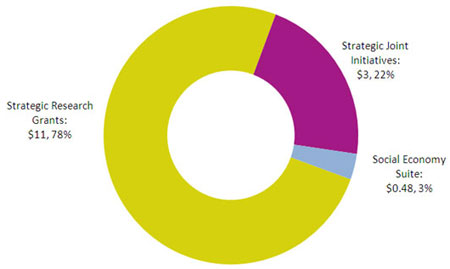
2010-11 Financial Resources ($ millions)
| Planned Spending | Total Authorities | Actual Spending |
|---|---|---|
| 19.8 | 20.4 | 16.0* |
2010-11 Human Resources (FTEs)
| Planned | Actual | Difference |
|---|---|---|
| 14 | 13 | -1 |
| Expected Results | Performance Status |
|---|---|
| Excellent SSHRC-funded research targeted in areas of importance to Canadians (as defined by SSHRC, in consultation with the research community and various stakeholders). | Mostly met |
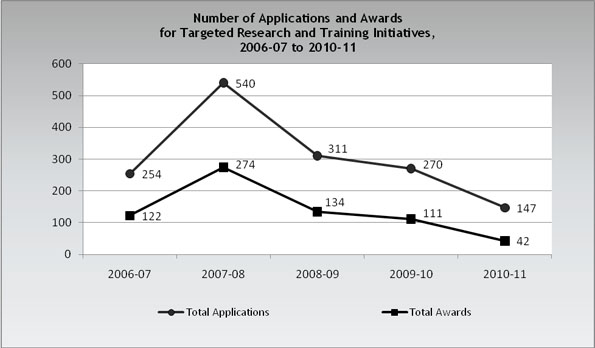
The decline in the number of applications under the Targeted Research and Training Initiatives program activity is a reflection of the realignment and streamlining of funding opportunities as SSHRC initiated the implementation of its program activity renewal. A number of highly focused targeted funding opportunities with relatively low award amounts were ended, and the higher-value Partnership Development Grants and Insight Development Grants funding opportunities were implemented.
Performance summary and analysis of program activity
A successful knowledge-based economy in Canada depends on citizens with strong analytical skills and an aptitude for enquiry. Targeted SSHRC-funded research contributed to the development of research capacity in areas of importance to Canadians, in regions like the North, or in key subject areas (i.e., the environment; or management, business and finance), or among specific groups.
Improving Finance and Monetary Systems
In 2007, the Government of Canada announced a budget increase of $11 million for targeted research in management, business and finance. This investment is influencing the way research and related activities are conducted and, in some cases, leading to breakthroughs in commercialization and value-added activities. For example, banks, insurance companies and governments are using tools developed by HEC Montr�al’s Georges Dionne to analyze risk and increase Canada’s financial security. The Bank of Canada uses Dionne’s work to predict the default risk of publicly traded Canadian companies. The Quebec government uses a system created by Dionne to set automobile insurance prices, and a large European insurance company reduced insurance fraud by 40 per cent using Dionne’s research on fraud detection.
In 2010-11 artist researchers were supported by the Research/Creation Grants in Fine Arts funding opportunity; and aboriginal scholars and the aboriginal community benefited from the capacity-building Aboriginal Research funding opportunity, which offered both development and research grants.
Distribution of Grants and Scholarships Spending in the Area of Strategic Research Grants, 2010-11 ($ millions and %)
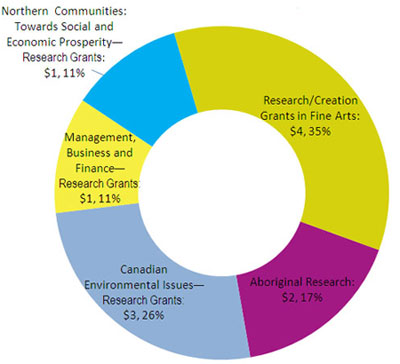
Strategic Joint Initiatives
SSHRC maintained or renewed investments in selected, targeted joint initiatives with a number of partners in 2010-11. These initiatives included:
- the Metropolis Project, funded by SSHRC and a consortium of 15 federal departments and agencies led by Citizenship and Immigration Canada;
- the Canadian Initiative on Social Statistics, with CIHR and Statistics Canada; and
- the Sport Participation Research Initiative in partnership with the Department of Canadian Heritage.
These initiatives gave researchers access to resources or funding to conduct timely research and share useful results with the funding partners, researchers and other interested Canadians. Through these joint activities, more than $3 million were invested in 2010-11 to support targeted activities in partnership with other fund providers, including government, private and community organizations.
Joint initiatives were also negotiated in 2010-11 with Policy Horizons Canada (formerly known as the Policy Research Initiative), and the National Association of Friendship Centres in collaboration with Aboriginal Affairs and Northern Development Canada (formerly known as Indian and Northern Affairs Canada).
In 2010-11, targeted funds for research in management, business and finance were directed towards subtopics in the priority area of Innovation, Leadership and Prosperity. This strategic investment could result in significant impacts, as indicated in Better Research for Better Business, an assessment provided by the Council of Canadian Academies.
SSHRC monitored the progress of university-based researchers receiving funding allocated in Budget 2008 to pursue research addressing environmental issues important to Canadians and issues important to northern communities. Further, these two priority areas were strategically prioritized across SSHRC’s program activity areas through funding opportunities for knowledge mobilization and partnership development activities.
Lessons learned
According to potential partners and researchers, the wide variety of partnership approaches and funding competitions available was creating confusion about SSHRC objectives, and contributing to diffusing efforts and resources of all those involved. As a result, in December 2010, SSHRC commissioned a review and environmental scan of research funding partnerships and partnering mechanisms, models, and practices. The review clarified SSHRC’s role in supporting partnerships negotiated by researchers and postsecondary institutions for research, training and knowledge mobilization activities. The review confirmed some duplication of effort with respect to shared research funding between SSHRC and other parties. However, it also found that selected, targeted partnerships between SSHRC and others were appropriate for longer-term multi-institutional research and mobilization activities (such as the Metropolis Project or the Canadian Initiative on Social Statistics). The review also found considerable support for strategic, “open” researcher-negotiated partnerships, supported in part by SSHRC (as typified through the Partnership Development Grants described in the next section).
Program Activity 2.3: Strategic Research Development
Strategic grants through programs in this program activity are available to faculty, postsecondary institutions, scholarly associations and not-for-profit organizations to explore, develop and define new perspectives, challenges, and priorities in conducting research, in disseminating research results, and in training new researchers. Strategic research development programs also help develop related research capacity through the promotion of new modes of research collaboration and partnerships.
Distribution of Grants and Scholarships Spending in the Area of Strategic Research Development, 2010-11 ($ millions and %)
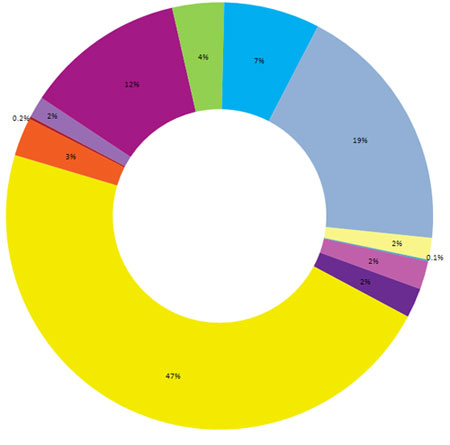
 Aid to Small Universities: $1
Aid to Small Universities: $1 Community-University Research Alliances: $13
Community-University Research Alliances: $13 International Community-University Research Alliances (SSHRC/IDRC):$1
International Community-University Research Alliances (SSHRC/IDRC):$1 International Joint Venture Project:$0.1
International Joint Venture Project:$0.1 International Opportunities Fund: $0.4
International Opportunities Fund: $0.4 Partnership Development Grants: $3
Partnership Development Grants: $3 Other Strategic Research Development: $1
Other Strategic Research Development: $1 Research Development Initiatives: $2
Research Development Initiatives: $2 SSHRC Institutional Grants: $5
SSHRC Institutional Grants: $5 Connections (Canadian Federation for the Humanities and Social Sciences): $0.5
Connections (Canadian Federation for the Humanities and Social Sciences): $0.5 Interagency Advisory Panel on Research Ethics: $0.03
Interagency Advisory Panel on Research Ethics: $0.03 Presidential Fund: $1
Presidential Fund: $1
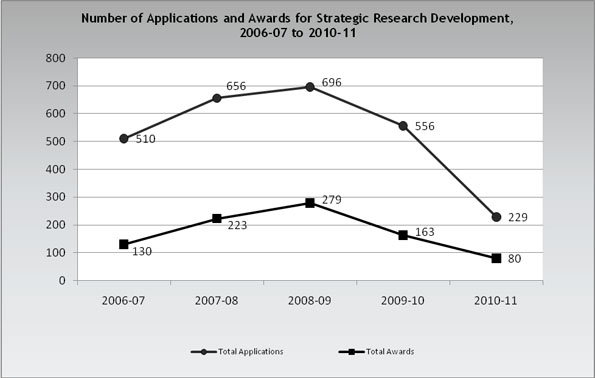
The decline in the number of applications under the Strategic Research Development program activity is a reflection of the realignment and streamlining of funding opportunities as SSHRC initiated the implementation of its program activity renewal.
2010-11 Financial Resources ($ millions)
| Planned Spending | Total Authorities | Actual Spending |
|---|---|---|
| 26.3 | 29.3 | 27.0 |
2010-11 Human Resources (FTEs)
| Planned | Actual | Difference |
|---|---|---|
| 8 | 7 | -1 |
| Expected Results | Performance Status |
|---|---|
| Research institutions are supported to conduct research development. New research and new researchers are attracted in strategic and targeted areas. | Mostly met |
Performance summary and analysis of program activity
SSHRC undertook targeted strategic activities in collaboration with Canadian and international partners:
- With the National Endowment for the Humanities (United States), the National Science Foundation (United States) and the Joint Information Systems Committee (United Kingdom), SSHRC monitored and assessed the initial outcomes of the first Digging into Data Challenge. The Council on Library and Information Resources completed the first phase of the assessment of the challenge, including interviews with each granting agency and all award winners.
- The cluster evaluation of the International Opportunities Fund with another international funding opportunity, the European Science Foundation’s Collaborative Research Scheme (EUROCORES) BOREAS: Histories from the North, was cancelled.
- The evaluation of the SSHRC Institutional Grants (SIG) and Aid to Small Universities (ASU) funding opportunities confirmed their relevance to the research activities of postsecondary institutions and indicated a strong percieved need for this support, especially by small institutions. The wide range of activities funded speaks to the broad objectives of the funding opportunities, and to the flexibility afforded to institutions in addressing their own priorities and needs. The evaluation also indicated that the development of a more clearly defined focus for SSHRC institutional funding may provide more targeted results in the future. The evaluation concluded that the SIG/ASU funds were spent on activities aligned with the current objectives of the funding opportunities, and that the funding was delivered effectively.
- In partnership with the International Development Research Centre (IDRC), SSHRC continues to monitor the activities of the first cohort of four International Community-University Research Alliances. In 2010-11, SSHRC contributed more than $790,000 to support the 51 Canadian researchers involved in these international research activities.
In 2010-11, SSHRC developed and launched the Partnership Development Grants, a partnered funding opportunity for research and/or significant knowledge mobilization. The funding opportunity requires a formal partnership (with financial and/or in-kind contributions) from postsecondary institutions and the public, private or community sectors. SSHRC funded 45 partnerships involving 350 researchers and 192 partners representing multiple sectors from within Canada and internationally. The funding opportunity’s 2010-11 investment of $3.3 million leveraged partner cash contributions and in-kind commitments of just over $1.8 million.
Research addressing issues within SSHRC priority areas was encouraged in the first Partnership Development Grants competition. More than three quarters of applications (77 per cent) selected a priority area.
Partnership Development Grants by Priority Area, 2010-11
| Priority Area | Applications Funded | Total Award | |
|---|---|---|---|
| # | % | $ thousands | |
| Aboriginal Research | 7 | 15.6 | 1,533 |
| Canadian Environmental Issues | 2 | 4.4 | 395 |
| Digital Media | 9 | 20.0 | 1,766 |
| Innovation, Leadership and Prosperity | 13 | 28.9 | 2,635 |
| Northern Communities: Towards Social and Economic Prosperity | 4 | 8.9 | 745 |
| Open—No Priority Area Selected | 10 | 22.2 | 1,920 |
| TOTAL | 45 | 100.0 | 8,996 |
Lessons learned
In delivering research and training funding to targeted research priority areas, SSHRC noted the continued need to respond to and engage with a complex and diverse audience of researchers and off-campus user communities. Through its engagement strategy, SSHRC has increased its efforts to speak with, listen to and learn from leaders in the private, public and not-for-profit sectors. The results are meeting our objectives of promoting greater awareness and understanding of SSHRC and the contribution of social sciences and humanities research in their respective areas of interest, as well as generating interest in future collaboration. This is particularly relevant in fulfilling the goals of SSHRC’s partnership strategy, which focuses on increasing knowledge co-creation and mobilization between researchers and collaborators across disciplines and across sectors—nationally and internationally—for mutual benefit.
Through an online consultation in April 2010, SSHRC received feedback on its new program architecture from postsecondary institutions, researchers and the not-for-profit and private sectors. In June 2010, SSHRC presented its new programs at the Congress of the Humanities and Social Sciences—an event that each year attracts 10,000 delegates and intense media coverage. Webinars and presentations on the Partnership Development Grants and Partnership Grants funding opportunities were hosted for postsecondary and private-sector audiences throughout the year, and an expert panel representing the academic, not-for-profit and private sectors helped guide SSHRC’s decisions on new funding opportunities as they took shape.
Strategic Outcome 3.0: Knowledge Mobilization—Facilitating the use of social sciences and humanities knowledge within and beyond academia
A knowledge-based society requires effective and productive interaction and collaboration between those who perform research and those who use it. SSHRC’s support of knowledge dissemination, translation and outreach creates connections between the research community and the larger community, allows for fruitful exchanges and the cross-fertilization of ideas, fosters an entrepreneurial attitude, and will help Canada continue its transition to a knowledge-based society.
Distribution of Spending in the Area of Knowledge Mobilization, 2010-11 ($ millions and %)
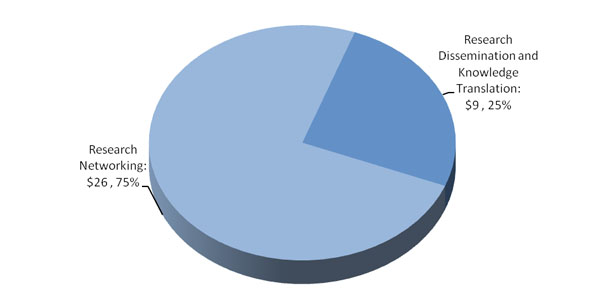
In 2010-11, SSHRC awarded 291 grants through the two program activities under Knowledge Mobilization. Funding through this strategic outcome represented $35 million. Overall, knowledge mobilization funding constituted five per cent of SSHRC’s grants expenditures in 2010-11.
Program Activity 3.1: Research Dissemination and Knowledge Translation
This program activity supports the effective dissemination of social sciences and humanities research results, both within and beyond academia. With grants to researchers and research institutions, it helps to ensure that research results are accessible to potential users, through both dissemination and engagement activities. Accessibility entails both the availability of research results to a range of audiences through publications (research publishing), as well as the tailoring of research results to the needs of potential users (knowledge translation).
Distribution of Grants and Scholarships Spending in the Area of Dissemination and Knowledge Translation, 2010-11 ($ millions and %)
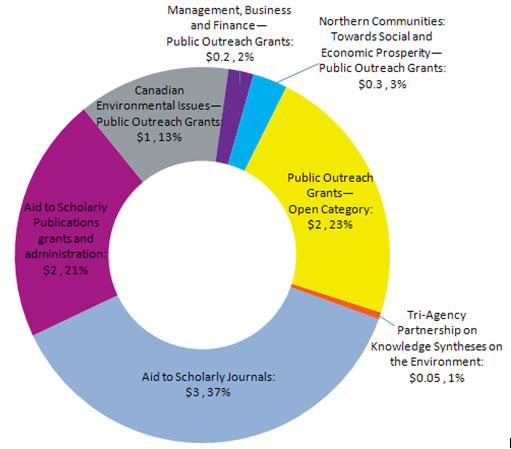
2010-11 Financial Resources ($ millions)
| Planned Spending | Total Authorities | Actual Spending |
|---|---|---|
| 7.2 | 7.2 | 8.9* |
*The variance between planned and actual spending relates to increased spending in grants.
2010-11 Human Resources (FTEs)
| Planned | Actual | Difference |
|---|---|---|
| 3 | 4 | +1 |
| Expected Results | Performance Status |
|---|---|
| Effective dissemination of research results both within and beyond academia. | Met all |
Performance summary and analysis of program activity
SSHRC awarded 43 new Public Outreach Grants in support of the effective mobilization and implementation of research and research results. Just over 50 per cent of these were in the three SSHRC priority areas listed in the table below.
Public Outreach Grants by Priority Area, 2010-11
| Priority Area | Applications Funded | Total Award | |
|---|---|---|---|
| # | % | $ millions | |
| Canadian Environmental Issues | 16 | 37.2 | 1.1 |
| Innovation, Leadership and Prosperity | 4 | 9.3 | 0.2 |
| Northern Communities: Towards Social and Economic Prosperity | 2 | 4.7 | 0.2 |
| Open—No Priority Area Selected | 21 | 48.8 | 1.9 |
| TOTAL | 43 | 100.0 | 3.4 |
Through the Public Outreach Grant funding opportunity, SSHRC ensured that researchers undertaking studies in areas of strategic importance to Canada (through SSHRC’s priority areas of Canadian Environmental Issues; Innovation, Leadership and Prosperity; and Northern Communities: Towards Social and Economic Prosperity) had opportunities to engage creatively with the broader public by sharing knowledge and enhancing the process through which research is put to use.
| Program | Description | Targets 2010-11 | Results 2010-11 | Expenditures 2010-11 ($ millions) |
|---|---|---|---|---|
Public Outreach Grants
|
Public Outreach Grants are designed to mobilize and/or leverage research in the social sciences and humanities for a range of audiences. This funding opportunity supports effective ways to disseminate, transfer, exchange, synthesize and broker research results to wider audiences who stand to benefit from research results (e.g., policy-makers, business leaders, community leaders, educators, and members of the media, as well as academics in various fields). | N/A | 43 grants | 3.48 |
| Tri-Agency Partnership on Knowledge Syntheses on the Environment (CIHR, NSERC, SSHRC) | The partner granting agencies offered grants to support expert syntheses on complex interactions between the environment and one or more other sectors—particularly health, energy and natural resources, and information and communications technology. | N/A | 1 grant | 0.05 |
| Knowledge Synthesis Grants on the Digital Economy | Knowledge Synthesis Grants enable experts to bring together knowledge available on key public policy issues to contribute to advancing the digital economy agenda and identifying knowledge gaps in areas that are critical for Canada (e.g., building digital skills, or creating and maintaining Canada’s digital content advantage). | N/A | 25 grants | 0.56 |
| Aid to Research Workshops and Conferences | Objectives of this funding opportunity include advancing research and scholarship on issues of intellectual, cultural and social importance by facilitating direct interaction among researchers and students; promoting research development, linkages and knowledge mobilization among disciplines and across institutions, sectors, linguistic groups, and regions; and enhancing the visibility and profile of social sciences and humanities research. | N/A | 222 grants | 4.99 |
Through implementation of the Knowledge Mobilization Strategy across SSHRC funding opportunities, and through the Public Outreach Grant funding opportunity itself, SSHRC, Canadian and international policy-makers, business and community leaders, educators, media representatives, and countless others benefit from SSHRC-funded activities such as workshops; policy briefs; public debates; development of interactive technology, software and Internet tools; and artistic exhibitions and performances. The goals of these activities are to enhance access to, and maximize the impact of, social sciences and humanities research.
SSHRC’s Knowledge Mobilization Strategy led to results in areas of key importance to Canadians. Over 1,500 award holders submitted final research reports in 2010-11. Fifty-two per cent of these award holders indicated that their research’s primary areas of impact were social or cultural in nature, and fully 45 per cent indicated that their research results impacted the development of programs and policies, contributed to public debate or had economic impacts.
Areas of Impact for Award Holders Reporting in 2010-11 (%)
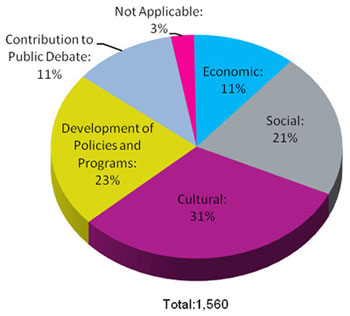
These researchers also reported that their findings were disseminated widely—well beyond the academic research audience. Forty-one per cent reported that their findings were circulated to a general, public audience, and 46 per cent specifically indicated decision-makers as their targeted audience.
Target Audience for Award Holders Reporting in 2010-11 (%)
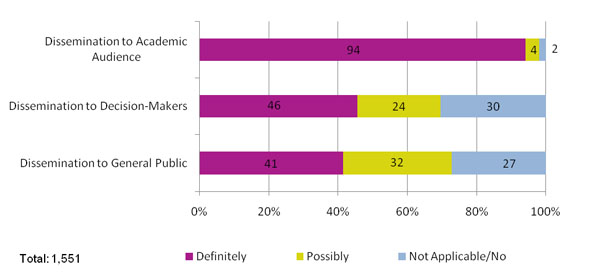
Finally, 60 per cent of the researchers reporting back in 2010-11 indicated their findings would definitely or likely enhance infrastructure in some way. The majority of researchers noted that their research outcomes would contribute to international collaboration. Almost all (more than 90 per cent) reported that their results were definitely or likely to contribute to knowledge in other disciplines, or to the improvement of research methods or teaching or professional practice—all impacts closely aligned with SSHRC’s mandate.
Impacts of Funded Research for Award Holders Reporting in 2010-11 (%)
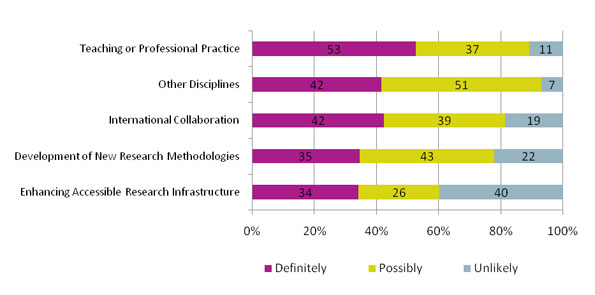
Lessons learned
Public Outreach peer review committee members were asked to contribute their suggestions for program policy revisions, particularly in relation to SSHRC’s Connection grants for individuals and teams. There was positive reception to plans to integrate the Aid to Research Workshops and Conferences and Public Outreach competitions, given the committee’s perception that there was increasing convergence in academic and non-academic purposes and participation. Two members of the Aid to Research Workshops and Conferences committee were asked to join the Public Outreach committee, to examine the feasibility of combining the two competitions. This committee also provided suggestions on how to define and distinguish different types of events and audiences, proposing a number of business rules. They also offered suggestions on how to ensure the effective impact of academic research on public policy, proposing best practices and training. These suggestions are being used to guide the development of the Connection grants funding opportunities to be launched in 2012 as part of SSHRC’s program architecture renewal.
Program Activity 3.2: Research Networking
This program activity supports interactions between researchers (in academia and other sectors) and between researchers and users of research results (in a range of sectors). These interactions enable researchers, research trainees and others to share and collaborate on research plans and results. Research networking is an important part of the research enterprise that is difficult to fund through traditional research grants. Dedicated funding for networking activities acknowledges its important role in fostering high-impact research and innovation. Research networking is supported through grants to researchers and research institutions to fund both discrete events such as conferences and workshops as well as more sustained collaborative relationships such as research networks and clusters.
Distribution of Grants and Scholarships Spending in the Area of Research Networking, 2010-11 ($ millions and %)
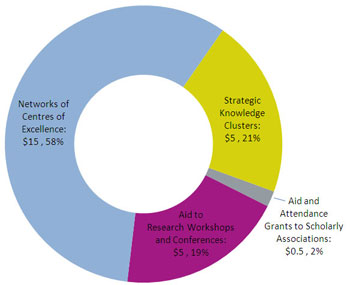
2010-11 Financial Resources ($ millions)
| Planned Spending | Total Authorities | Actual Spending |
|---|---|---|
| 24.9 | 24.0 | 26.1* |
2010-11 Human Resources (FTEs)
| Planned | Actual | Difference |
|---|---|---|
| 3 | 5 | +2 |
| Expected Results | Performance Status |
|---|---|
| Researchers interact and work with each other, across disciplines and sectors, and with potential users of research in a range of sectors outside of academia in the public, private and not-for-profit sectors. | Met all |
Performance summary and analysis of program activity
The results of the first Networks of Centres of Excellence (NCE) Knowledge Mobilization competition highlighted the importance of social sciences and humanities research. In September 2010, 50 letters of intent were received, of which 17 were in areas related to the social sciences and humanities. Of the eight recommended as NCE finalists for the full application stage (to take place in 2011-12), three were from the social sciences and humanities. One team is seeking to continue examining violence reduction and the promotion of positive social relationships; the second is working to address issues of children and youth in challenging contexts; and the third proposes to examine the challenges facing forestry-based communities in a period of prolonged social and economic transition.
The 2010 NCE annual meeting was attended by representatives of NCE networks and centres, as well as Canadian leaders from publicly funded research organizations and private enterprises. Participants discussed the nature of innovation and the progress both made and needed to further the mobilization of innovation in Canada. SSHRC president Chad Gaffield contributed a strong social sciences and humanities focus to the event, as did other researchers in these disciplines. These researchers shared several success stories about initiatives that have engaged user communities in university research, including a research helpdesk that connects experts in academia with non-governmental organizations, private enterprise and government.
Lessons learned
The NCE Knowledge Mobilization competition results to date demonstrate the potential of the NCE approach to have further impacts and outcomes in the social sciences and humanities. Similarly, it is clear that NCE events provide an ideal venue for highlighting social sciences and humanities impacts, trends and avenues for exploration.
The peer review committee members for the Aid to Research Workshops and Conferences competitions were asked to contribute suggestions and feedback for improvements to program policy and practices. As in other committees, there was positive reception to plans to integrate the Aid to Research Workshops and Conferences and Public Outreach competitions, although members recommended ensuring that events geared to academic dissemination remain feasible alongside events and other projects geared more to the engagement of non-academic sectors. These suggestions are being used to guide the development of Connection grants funding opportunities for individuals and teams.
Strategic Outcome 4.0: Institutional Environment—A strong Canadian science and research environment
Funding provided to institutions to maintain world-class research environments supports them in attracting and retaining the top researchers whose work is critical to Canada’s science, technology and innovation system. Program activities in support of the institutional environment ensure that Canada has well-equipped, appropriately staffed research facilities that meet regulatory requirements and international accreditation standards and enhance Canada’s reputation as a setting for research excellence. Other activities allow institutions to administer research projects and to provide the legal, marketing or financial services associated with commercialization.
Program Activity 4.1: Indirect Costs of Research
In Canada, the provincial and federal governments jointly support academic research. The provinces provide the basic physical infrastructure and, supported in part by the Canada Health and Social Transfer, direct and indirect operating costs. The federal government funds the direct costs of research, mainly through the three federal research granting agencies—CIHR, NSERC and SSHRC.
The term “indirect costs” refers to the central and departmental costs that institutions incur to support research, but that are not readily attributable to specific research projects. In its 2003 budget, the Government of Canada announced a new program to support the indirect costs associated with the conduct of academic research in institutions that receive research grant funds from any of the three federal granting agencies. This grant program recognizes the growing indirect costs of conducting publicly funded academic research.
By financing a portion of the indirect costs incurred by postsecondary institutions and their affiliated research hospitals and institutes, the federal government both supports world-class research facilities and addresses the needs of smaller Canadian postsecondary institutions.
The Indirect Costs Program is administered by the SSHRC-hosted Chairs Secretariat on behalf of the three federal research granting agencies. The entire program budget flows through SSHRC.
2010-11 Financial Resources ($ millions)
| Planned Spending | Total Authorities | Actual Spending |
|---|---|---|
| 322.4 | 329.7 | 329.7* |
2010-11 Human Resources (FTEs)
| Planned | Actual | Difference |
|---|---|---|
| 3 | 5 | +2 |
| Expected Results | Performance Status |
|---|---|
| Universities and colleges have the necessary resources, research facilities and services to carry out and mobilize world-class research. | Met all |
Performance summary and analysis of program activity
Since the Indirect Costs Program’s inception in 2001, SSHRC has allocated, on behalf of the three granting agencies, more than $2.5 billion in grants to more than 140 eligible Canadian postsecondary institutions. Indirect Costs grants equalled $329.3 million in 2010-11, providing vital support to the academic research environment in Canada.
The Indirect Costs Program provides support in five priority expenditure areas: research facilities, research resources, management and administration, regulatory requirements and accreditation, and intellectual property management. The program’s funds have benefited research capacity in all five areas for the entire range of institutions. Indirect Costs grants have allowed Canadian research institutions to raise their research profiles both at home and abroad, by supporting public outreach and private partnerships. This has been especially true for small and mid-size institutions with relatively young research programs. The funds, through their support of research administration and accounting services, have also contributed meaningfully by allowing for increased accountability and effectiveness in the research enterprise. By removing some of the administrative burden from researchers and centralizing research funding management, many institutions have been able to significantly improve their ability to track funding and to enhance the support provided to their researchers at various levels.
Supporting the Research Enterprise
"The [Indirect Costs Program] is an essential component in the suite of federal research funding, and from UOIT’s perspective—one that is most likely shared by other small institutions—essential to the continued growth and support of the research enterprise. The research landscape is continuing to grow in complexity, and with it there are more stringent stewardship and accountability requirements; to ensure UOIT’s compliance, dedicated and knowledgeable human resources are required. The [Indirect Costs Program] for UOIT provides the means to attract and retain exceptional professionals in key positions. This translates to building a strong, supportive research environment for faculty members, in order for them to direct their attention to research and training of highly qualified personnel."
University of Ontario Institute of Technology
As a whole, institutions funded by the program use their grants largely for management and administration and for research facilities. Combined, these two categories accounted for 67 per cent of total spending in 2010-11. The distribution of funds among the five expenditure areas has remained fairly stable since the program’s inception, with a gradual increase in the proportion of funds allotted to regulatory requirements and accreditation, as well as to management and administration, offset by a similar decline in the proportion spent on resources and facilities.
Proportion of Grants Budget Allocated to Priority Expenditure Areas, 2009-10*
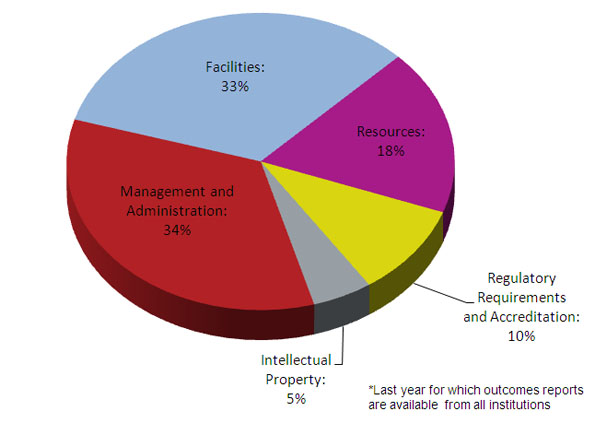
Lessons learned
In response to a recommendation from the Indirect Costs Program evaluation carried out in 2008-09, program management committed to working with the university community to establish a baseline measurement of the state of the research environment in Canada. A working group comprising senior administrators from various organizations (universities, the Association of Universities and Colleges of Canada, the Canadian Association of University Business Officers, and the Canadian Association of University Research Administrators) has been tasked with identifying a set of indicators to assess the health of the postsecondary research environment every five years.
The working group determined that, to be successful, the initiative must be undertaken in close collaboration with the university and research communities, it must recognize and leverage the existing needs and motivations of universities and stakeholder groups to collect and use data, and it must not add significantly to the reporting burden of institutions. Most of the necessary indicators should already be available from various sources.
To date, the working group has identified indicators for three of the five components that define the health of the research environment (i.e., quality of facilities; availability and quality of research resources; and management and administration capacity). Work continues on identifying indicators for the two remaining components (degree of regulatory compliance; and intellectual property management capacity).
Program Activity 5.1 Internal Services
Internal Services are groups of related activities and resources that are administered to support the needs of programs and other corporate obligations of an organization. These groups are: Management and Oversight Services; Communications Services; Legal Services; Human Resources Management Services; Financial Management Services; Information Management Services; Information Technology Services; Real Property Services; Materiel Services; Acquisition Services; and Travel and Other Administrative Services. Internal Services include only those activities and resources that apply across an organization and not to those provided specifically to a program.
2010-11 Financial Resources ($ millions)
| Planned Spending | Total Authorities | Actual Spending |
|---|---|---|
| 16.6 | 18.0 | 17.3 |
2010-11 Human Resources (FTEs)
| Planned | Actual | Difference |
|---|---|---|
| 128 | 110 | -18 |
SSHRC and NSERC use a common administrative services model for their general administration and for services relating to human resources, finance, awards administration, and information and technology management. This shared approach has proven highly efficient. SSHRC has separate units providing corporate services related to governance, policy, planning, statistics, program evaluation, performance measurement, audit, communications and international affairs.
SSHRC continued to transform its business tools and processes, and initiated the review of available and custom electronic and integrated grant application and award management systems.
SSHRC implemented components of its human resources strategy, known as the People Strategy, focusing on recruitment development and retention of highly qualified and experienced staff to maintain capacity.
Section III: Supplementary Information
Financial Highlights
SSHRC 2010-11 Condensed Statement of Financial Position
As of March 31, 2011 ($ thousands)
| Percentage Variance | 2010-11 | 2009-10 | |
|---|---|---|---|
| Total Assets | 31.4% | 6,931 | 5,276 |
| Total Liabilities | 8.5% | 7,895 | 7,278 |
| Total Equity | 51.8% | (964) | (2,002) |
| Total Liabilities and Equity | 31.4% | 6,931 | 5,276 |
Condensed Statement of Operations
For the year ended March 31, 2011 ($ thousands)
| Percentage Variance | 2010-11 | 2009-10 | |
|---|---|---|---|
| Total Expenses | 0.3% | 690,192 | 688,109 |
| Total Revenues | 0.0% | 1 | 1 |
| Net Cost of Operations | 0.3% | 690,191 | 688,108 |
As illustrated below, the Social Sciences and Humanities Research Council (SSHRC) allocates 96 per cent of its available budget directly to researchers and institutions across Canada to support university- and college-based research and training in the social sciences and humanities.
Allocation of SSHRC Expenditures Between Grants and Operating Expenses, 2010-11 ($ millions and %)
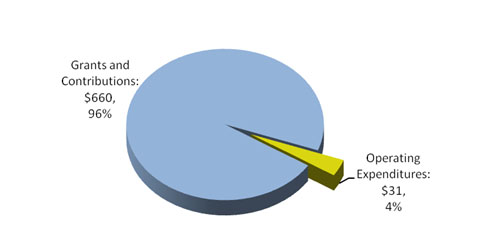
Financial Statements
SSHRC’s audited financial statements are available in SSHRC’s Annual Report 2010-11.
SSHRC’s Annex to the Statement of Management Responsibility Including Internal Control Over Financial Reporting can be found on SSHRC’s website at www.sshrc-crsh.gc.ca/about-au_sujet/publications/annual_reports-rapports_annuels-eng.aspx
List of Supplementary Information Tables
All electronic supplementary information tables found in SSHRC’s 2010-11 Departmental Performance Report can be found on the Treasury Board of Canada Secretariat’s website:
- Sources of Respendable and Non-Respendable Revenue
- Details on Transfer Payment Programs
- Green Procurement
- Internal Audits and Evaluations
Section IV: Other Items of Interest
Additional Information
Results-Based Action Plan for the Implementation of Article 41 of the Official Languages Act 2009-12
Status Report on the Implementation of Article 41 of the Official Languages Act
Organizational Contact Information
Carmen Charette
Executive Vice-President
Social Sciences and Humanities Research Council
350 Albert Street
P.O. Box 1610
Ottawa, ON K1P 6G4
Telephone: 613-947-5265
Fax: 613-947-4010
Email: carmen.charette@sshrc-crsh.gc.ca
Wayne MacDonald
Director
Corporate Performance and Evaluation Division
Social Sciences and Humanities Research Council
350 Albert Street
P.O. Box 1610
Ottawa, ON K1P 6G4
Telephone: 613-992-5125
Fax: 613-947-0223
Email: wayne.macdonald@sshrc-crsh.gc.ca
Ursula Gobel
Director
Communications Division
Social Sciences and Humanities Research Council
350 Albert Street
P.O. Box 1610
Ottawa, ON K1P 6G4
Telephone: 613-992-4283
Fax: 613-992-2803
Email: ursula.gobel@sshrc-crsh.gc.ca

 [D]
[D]